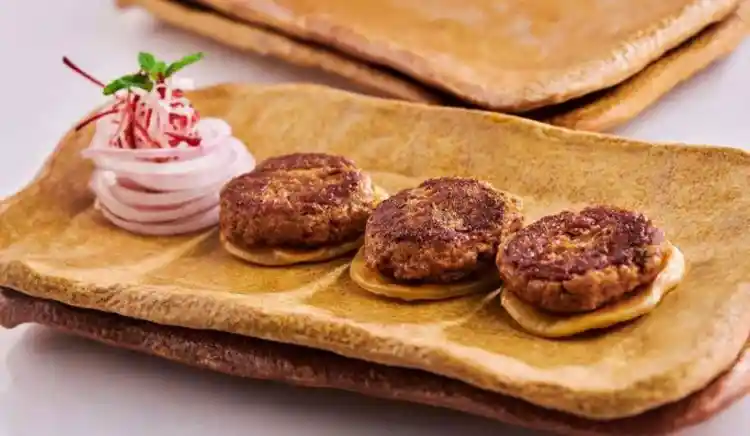Galouti Kebab: Kebab For A Toothless Nawab
Cooking for the royal families is an honour, but at the same time, it is a huge responsibility. From preparing the best dishes to using the best spices, the royal palate can be very demanding. But what happens when the royal chef finds a way to combine soft and succulent minced meat with one hundred and sixty spices to create a delicacy that would change food history?

Galouti Kebab. Image Credits: Eazy Diner
In the narrow gullies (lanes) of Delhi and Lucknow, one can see dozens of shops where expert hands: mix the right amount of spices along with minced meat, give the meat a cylindrical shape with the help of a kebab stick, and put it on a griller to make the perfect mouthwatering kebabs.
Kebabs, today are one of the most sought- after starters- be it in expensive restaurants or roadside dhabas. Most of us are of the view that these kebabs have originated from the Mughal rasoi. But there’s an altogether different story behind these delicious kebabs.
Ibn Sayyar al-Warraq first mentioned the kebabs in his Baghdadi cookbook, 'Kitab al-Tabikh'. This cookbook comprises some of the most famous and sought-after dishes made by Mesopotamians, Persian, and Arab. This cookbook describes a kebab as cut-up meat cooked or fried in a pan or a griller. While the modern kebabs are plated in unique styles, these ancient kebab dishes have emerged from the rasois of Persia and Anatolia. Beyond being grilled on skewers, antique kebab dishes also include stews and meatballs.
The Kebab has since swept across the world with its delectable taste and drool-worthy aroma. Ibn Battuta, the famous Moroccan traveler, wrote in his travelogue that kebabs were usually cooked in the royal houses of the Delhi Sultanate. With time, it became so famous that even the commoners began having naan and kebab for breakfast.
No matter the global heritage of kebabs, The king of kebabs hails from the beautiful city of Lucknow.
The city of art, culture, architecture, royalty, and food has many finger-licking dishes: Lucknowi Biriyani, Arvi ka Salan, Moti Pulao, Parind Puri, and dozens of kebab varieties. Every dish has a tale to tell, and one such legend from the rich culinary history of Lucknow tells us about the fascinating origin of the Galouti Kebab.
Prepared from the perfect amalgamation of minced meat and hundreds of varieties of spices, the word Galouti itself translates to “a dish that melts in the mouth.” Commonly found in every Lucknowi household, these kebabs first originated in Asad-ud-Daula’s kitchen, the famous Nawab of Bengal.
Asad-ud-Daula was the Nawab Wazir of Oudh in the late 1700s. Asad was highly fond of kebabs. His obsession with kebabs led him to hire an exceptional team of chefs who would experiment with all kinds of kebab varieties. Their duty was to present a new kebab dish every day in front of the Nawab.
The team experimented with almost everything, from different flavors like sandalwood, rose, juniper berries, and red ginseng to various flavoring techniques like slow cooking, grilling, frying, and smoke flavoring.
These cooks were monikered as khansamas. Even during the famine of 1783, his chefs indulged in finding newer kebab varieties to impress the Nawab. Asad was very generous. These kebabs were not eaten by him alone. He made sure that these were distributed among the court men and laborers who were helping him in building the famous monument of Bara Imambara. Asad had a famous motto, and he stuck to it- “Jo Khuda nahi dega, wo Asad dega.”
With time, the Nawab grew old and lost all his teeth. But his penchant for tasting newer varieties of kebabs never faded. Originally, kebabs were chewy and coarse, due to which the Nawab couldn’t enjoy them properly. Thus, the khansamas came up with a variety of kebabs that would not only taste delicious but also have a texture that requires no chewing.
Galouti Kebab was invented by Haji Mohammad Fakr-e-Alam Saheb, the same man who created Moti Pulao. When he presented his soft, creamy, and mouthwatering dish in the court, Galouti Kebab became the new obsession of Lucknow.
Rather than beef, Haji used the best cuts of lamb, minced finely, with a tenderizer and a magnificent blend of over one hundred and fifty unique spices to enhance flavor. The minced lamb meat was formed into patties and cooked in ghee for a delightful finish.
It is said that Haji had only one hand. With the help of his magical hand, he created one of the most legendary kebabs of Lucknow. And so goes the tale of the toothless nawab and one-armed chef; an usual combination that gave birth to the legendary Galouti Kebab.


